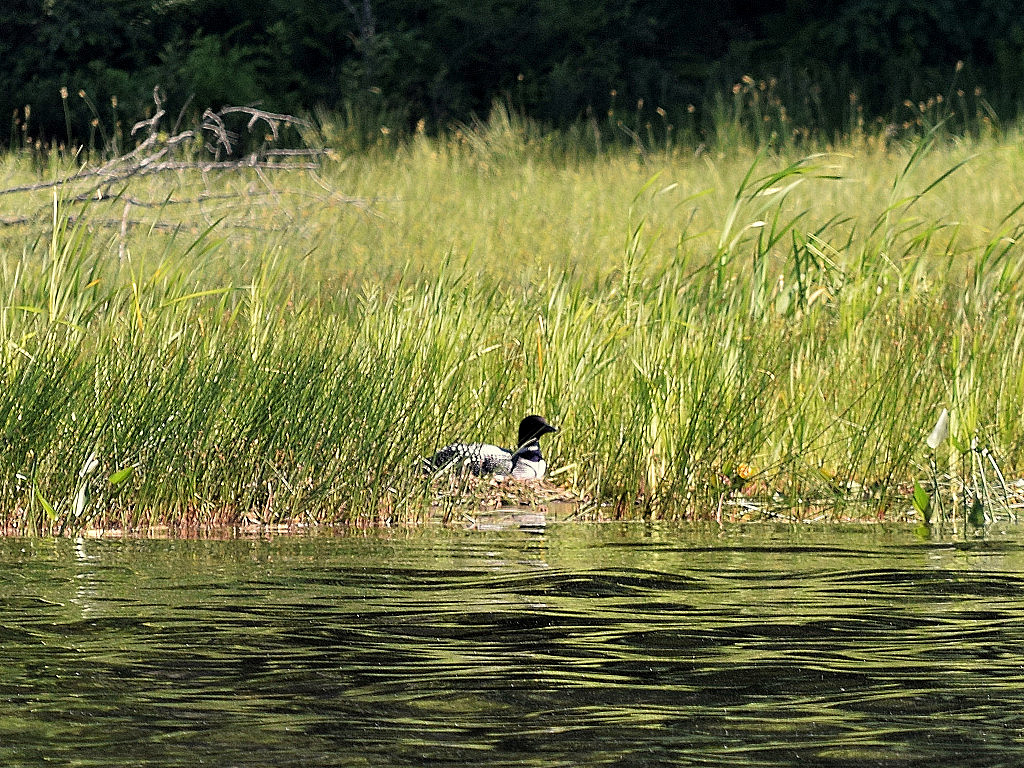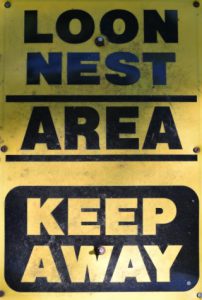 For the first time since the summer of 2012, a pair of loons is attempting to nest again on Clary Lake. This is fantastic news and it has us very excited. The nest is located at the end of the sandbar on the east end of the lake 800′ to 900′ feet northwest of the State Boat launch, opposite Randy and Arlene Wing’s home which is the white cape located next to the boat launch. In fact news of the loon nest was brought to my attention by Arlene Wing who sent me an email last night. David Hodsdon, Jack Holland, and I were scheduled to conduct our biweekly water quality monitoring data-collection exercise this morning and after we were done we boated over and confirmed that there is indeed a loon nest there. I was able to get a couple of pictures of the sitting loon without getting too close.
For the first time since the summer of 2012, a pair of loons is attempting to nest again on Clary Lake. This is fantastic news and it has us very excited. The nest is located at the end of the sandbar on the east end of the lake 800′ to 900′ feet northwest of the State Boat launch, opposite Randy and Arlene Wing’s home which is the white cape located next to the boat launch. In fact news of the loon nest was brought to my attention by Arlene Wing who sent me an email last night. David Hodsdon, Jack Holland, and I were scheduled to conduct our biweekly water quality monitoring data-collection exercise this morning and after we were done we boated over and confirmed that there is indeed a loon nest there. I was able to get a couple of pictures of the sitting loon without getting too close.
 Our resident Loon expert Mary Gingrow-Shaw (pictured at left) helped me round up the Association’s floating “LOON NEST AREA” signs which have been languishing in the weeds near my boat launch and together we headed over about noon today and set 3 of them just off shore from the sandbar to warn boaters away from the nest. Hopefully people will see these signs and give the loons the peace and solitude they require. People however are the least of the problems these marvelous bird face. They are vulnerable to attack by eagles from the air and coyotes and foxes from the shore. Once the eggs hatch (gestation period is 26 to 31 days) the risks only increase: I’ve seen more than a few baby loons snatched by snapping turtles than I care to remember.
Our resident Loon expert Mary Gingrow-Shaw (pictured at left) helped me round up the Association’s floating “LOON NEST AREA” signs which have been languishing in the weeds near my boat launch and together we headed over about noon today and set 3 of them just off shore from the sandbar to warn boaters away from the nest. Hopefully people will see these signs and give the loons the peace and solitude they require. People however are the least of the problems these marvelous bird face. They are vulnerable to attack by eagles from the air and coyotes and foxes from the shore. Once the eggs hatch (gestation period is 26 to 31 days) the risks only increase: I’ve seen more than a few baby loons snatched by snapping turtles than I care to remember.
By far the biggest threat these nesting loons now face is from fluctuating water levels. Their nest can either become stranded if the lake level falls too much, or get flooded if it rises too much. As you can see in the picture, loon nests don’t have a lot of freeboard- only 3″ or 4″ at most. An inch or 2 of rain is all it will take to bring the lake up that much and more.
These floating signs were built many years ago by long time Clary Lake Association member Edward Grant and were last used in 2012 when a loon pair attempted to nest in the marsh over on the west end of the lake by Route 126. Sadly, that nesting attempt failed when the nest was flooded. Let’s hope that doesn’t happen again. Please everyone, respect these signs and give the Loon nest a wide berth. We’ll be monitoring the nest from the shoreline and will post more pictures and updates as the summer progresses.


So happy Daddy’s signs are once again needed. He’s smiling from Heaven
Your father was a good steward of Clary Lake.
So exciting…its been several years since we been able to watch a loon family on the lake. I hope the water level remains stable while the birds are nesting….
I wonder how long the nest has been there? It’s quite well hidden, you have to be really looking for it to see it so it’s not hard to imagine it’s been there a while- a week or so anyways. The Audubon Loon Count is July 16th this year and it is expected that loons will have fledged their young well before that. With a gestation period of 26-30 days, if the lake level can remain relatively stable for a couple of weeks and nothing else goes wrong, we should see babies in a couple of weeks.
With the lake falling only 0.01′ to 0.03′ per day now, the greatest risk is from flooding. Needless to say, if the lake were being maintained where it should be this time of year, flooding would not be an concern.
I’ll bet that Arlene has a good idea of when the loons starting sitting on the nest.
As a matter of fact, I just got back from their place, she said that Randy first noticed the nest about 5-6 days ago. That would be around June 12th or 13th and I suspect it has been there a while longer than that. I went over to check out how visibly accessible the nest is from there. Turns out VERY ACCESSIBLE! I’ll post some pictures later today.
I’m getting a new long range lens next week and will hopefully be able to post some good pics for everyone. We’re beside ourselves with excitement! Just praying the chicks make it.
That’ll be great! Thank you so much! This will be the best documented loon nest in Clary Lake history 🙂 Particularly want pictures of the nest showing both loons and with your vantage point you should be able to see into the nest and show the eggs when the nest is unoccupied.
I’m going to try hooking my camera up to a 6″ F/5 Newtonian telescope. It’s intended for stars and planets but should work passably well for terrestrial use as well with some minor modifications.